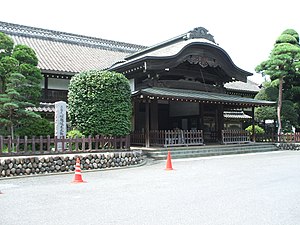Kawagoe Castle
| Kawagoe Castle | ||
|---|---|---|
|
Kawagoe Castle, entrance to the residence |
||
| Creation time : | 1457 | |
| Castle type : | Hirajiro (Lower Castle) | |
| Conservation status: | Residence z. T. received | |
| Place: | Kawagoe | |
| Geographical location | 35 ° 55 '28.3 " N , 139 ° 29' 29.4" E | |
|
|
||
The castle Kawagoe ( Japanese 川越城 , Kawagoe-jō ) is located in the city of Kawagoe in Saitama Prefecture . In the Edo period , the Matsui last resided there as the larger Fudai daimyo .
Lords of the castle in the Edo period
- From 1609 a branch of the Sakai with an income of 20,000 koku ,
- from 1634 a branch of the Hotta with 30,000 koku,
- from 1639 a branch of Ōkōchi with 60,000 koku,
- from 1694 the Yanagisawa with 72,000 Koku,
- from 1704 the Akimoto with 50,000 Koku,
- from 1767 a branch of the Matsudaira with 150,000 koku,
- from 1866 the Matsui with 80,000 Koku.
history
In 1457 Ōgigayatsu-Uesugi Mochitomo ( 扇 谷 上杉 持 朝 ; 1416–1467) ordered his important vassal Ōta Sukekiyo ( 太 田 資 清 ) and his son Sukenaga ( 資 長 ) to build a castle on the right bank of the Arakawa River . Surrounded by swampy terrain, it became a low castle. The size corresponded to the later innermost area, the Hommaru ( 本 丸 ; 1), the second area (Ni-no-maru, 二 の 丸 , 2) and the pre-area Miyoshino tenjin ( 三 芳 天 神曲 輪 , Miyoshino tenjin kuruwa ; C).
The Uesugi were rulers in the area until Kawagoe Castle was conquered in 1546 by Hōjō Ujiyasu ( 方丈 氏 康 ; 1515–1571) in a nocturnal attack known as the "Kawagoe Night Battle" (川 越 夜 戦, Kawagoe yasen) .
From 1590, when Tokugawa Ieyasu received the Kantō provinces, the castle was occupied by loyal vassals until the Meiji Restoration in 1868.
The attachment
When Matsudaira Nobutsuna ( 松 平 信 綱 ; 1596–1662), who was nicknamed “Chie'izu” ( 知 恵 伊豆 ), received the castle in 1639, he expanded it. The castle now consisted of the Hommaru, Ni-no-maru and San-nomaru (三 の 丸, 3). The Hommaru was now protected in the west by the Hachiman-kuruwa ( 八 幡 曲 輪 ; B). The castle had three watchtowers ( 櫓 , yagura ) and eight gates.
Under the Ōkōchi, the castle was fundamentally repaired and expanded again between 1644 and 1648. To the existing castle areas came to the west of the San-no-maru of Vorbereich Soto kuruwa ( 外曲輪 ; A), in the east of Hommaru the forecourt Shin-kuruwa ( 新曲輪 ; D) and in the south of Vorbereich Ta kuruwa ( 田曲 輪 ; E). There was still no castle tower ( 天 守 , tenshu ), its function was taken over by the three-story Fujimi watchtower (富士 見 櫓, marked in red). The main gate ( 大 手 門 , Ōte-mon , H) was in the far west.
Today the castle has largely become an urban area. In the former Hommaru, now Hatsukari Park ( 初 雁 公園 , Hatsukari-kōen ), part of the residence rebuilt in 1854 with its entrance area, the Kuruma-yose ( 車 寄 ), with reception rooms and the living area of the house elder have been preserved. It has a total area of 545 m². One of the rooms was laid out with 123 tatami mats and converted into a museum. Archaeological relics and images from the cultural heritage are exhibited there. The base of the Fujimi watchtower and the remains of a moat are also preserved.
Individual evidence
- ↑ Excerpt from the right screen of the pair of screens "Edo-zu byōbu" owned by the National Museum of Japanese History
literature
- Sugai, Yasuo: Kawagoe-jo in: Miura, Masayuki (Ed.): Shiro to jinya. Tokoku-hen. Gakken, 2006. ISBN 978-4-05-604378-5 , p. 100.
- Nishigaya, Yasuhiro (Ed.): Kawagoe-jo. In: Nihon meijo zukan, Rikogaku-sha, 1993. ISBN 4-8445-3017-8 .



